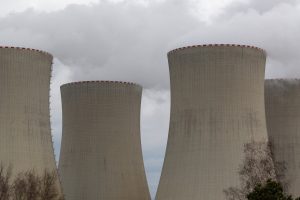On March 28, British Prime Minister Boris Johnson announced that in order to reduce its dependency on Russian gas and oil, the United Kingdom could increase its reliance on nuclear energy up to 25 percent of its energy needs. As the Russian invasion of Ukraine changes the global geopolitical system, and Europe and the U.K. look toward diversifying their energy suppliers, one winner from a greater future reliance on nuclear energy could be Kazakhstan’s uranium industry.
Certain energy companies are already cutting ties with Russian suppliers. Case in point: the Swedish nuclear energy company Vattenfall AB announced on February 24 a halt of planned deliveries of nuclear fuel from Russia and that it would not place new orders until further notice. Vattenfall’s President and CEO Anna Borg noted that “we have secured alternative deliveries of nuclear fuel.” Kazakhstan is already one of the company’s suppliers of uranium, but it is unclear if Vattenfall will procure additional uranium from the Central Asian country or from another source.
Kazakhstan and Europe are close partners regarding nuclear energy. Kazakhstan is the third-largest supplier of uranium to Europe, supplying 19.2 percent in 2020, after Niger (20.3 percent) and Russia (20.2 percent). The U.K. obtains its nuclear energy from both civilian plutonium and highly enriched uranium, and according to the World Nuclear Association, the U.K.’s “uranium is imported, as are conversion services.”
As London debates its civilian nuclear energy future, one key player to consider is Kazatomprom, Kazakhstan’s atomic company and the world’s largest producer of uranium. The company’s 2021 financial results, released in March, noted that production of Triuranium octoxide (U3O8), a compound of uranium, reached 19,477 tU in 2020, and increased by 12 percent to 21,819 tU in 2021. “Production volume in 2022 is expected to be between 21,000 tU and 22,000 tU,” the company explained, though it noted that pandemic-related supply chain challenges continue to limit access to some important materials and equipment.
An obvious question, given the intentions of European policymakers and companies to boost nuclear power generation, is whether European customers will reach out to Kazatomprom to feed increased demand of uranium. Kazatomprom has not publicly discussed this possibility, but new contracts are likely to be signed in the near future.
A March 18 commentary in The Conversation discussed Russia’s role as a key nuclear supplier. Even though Kazakhstan produces more than 40 percent of the global supply of uranium, the article noted that “much of the milled uranium from Kazakhstan travels through Russia before it is exported to global markets.” Moreover, “only a handful of facilities in the world convert milled uranium into uranium hexafluoride; Russia produced approximately one-third of the 2020 supply, much of it made with uranium from Kazakhstan.” While key logistical issues, including transportation to avoid Russia and conversion, will have to be figured out, Kazakhstan’s Kazatomprom is in an ideal situation to position itself as Europe’s reliable uranium supplier.
It is worth noting that the price of uranium has increased since the war in Ukraine started. The price was $30.35 per pound in January 2021, $45 on February 28 (four days after the invasion commenced), and reached $56.70 on March 25. As of writing, the price was pushing past $60 per pound. As the world’s major producer of uranium, Kazakhstan stands to win big.
Kazakhstan’s uranium deposits and nuclear-related activities are a sensitive issue from a historical perspective, given that its territory was utilized for massive nuclear testing during the Soviet period. After the Cold War, Kazakhstan, under President Nursultan Nazarbayev’s leadership, voluntarily gave up its vast nuclear arsenal. This was a rare post-Cold War example of Moscow and Washington, along with the nascent Kazakh state, working together to transfer nuclear warheads and other weapons back to Russia, while the Semipalatinsk test site and other facilities were dismantled.
While Nazarbayev’s rule has been recently criticized for his excessive centralization of power, relinquishing its nuclear arsenal was a commendable choice that was codified in the 2006 Central Asian Nuclear Weapons-Free Zone treaty, signed in Semipalatinsk, the location of the nuclear test range. The fact that Central Asia today does not have nuclear weapons across this vast territory stems from those decisions in the early 1990s.
Since achieving independence three decades ago, Kazakhstan has maintained a balanced and neutral foreign policy stance, a critical pillar of the multi-vector diplomacy initiated by Nazarbayev and continued by the current president, Kassym-Jomart Tokayev. As for trade and commerce, prior the war in Ukraine, Nur-Sultan was already aiming to diversify and expand its partnerships with Europe and the U.K. to attract more investment.
The war has put energy and food security at the top of the list of priorities for the U.K. and the rest of Europe, apart from deterring Russia. Kazakhstan has the potential to become a bigger supplier of uranium to Europe, thereby helping achieve energy security and demonstrate that the Eurasian nation is a reliable trade and energy partner.

































